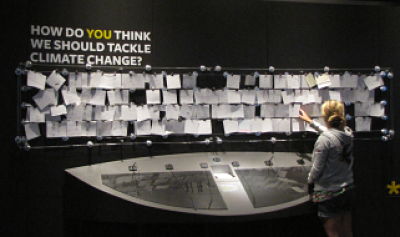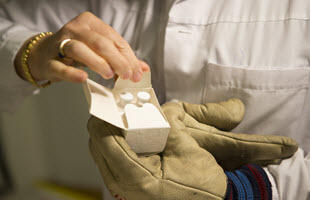In the Anthropocene, Every Discipline Has a Role
 There is a growing movement among writers, scientists, and scholars to pin a new label on our modern era. According to these thinkers, pressing environmental problems like climate change are a sign that we have crossed a major threshold in Earth’s long history, entering a unique stage in geological time that requires a shift in cultural outlook and even a new name – the “Anthropocene,” or the “Age of Us.”
There is a growing movement among writers, scientists, and scholars to pin a new label on our modern era. According to these thinkers, pressing environmental problems like climate change are a sign that we have crossed a major threshold in Earth’s long history, entering a unique stage in geological time that requires a shift in cultural outlook and even a new name – the “Anthropocene,” or the “Age of Us.”
In charting a hopeful path forward in the Anthropocene, universities and colleges will play a central role by sponsoring interdisciplinary courses, degree programs and related initiatives.

This article by Matthew Nisbet originally appeared at The Conversation, a Social Science Space partner site, under the title “Universities in the Anthropocene: engaging students and communities”
The goal is not for students, faculty and staff to choose among competing perspectives about the Age of Us and its many problems and opportunities. Instead, the purpose is to acquire skills, experience and connections that help the campus community grapple with the Anthropocene’s many tensions and uncertainties.
Universities and colleges can also invest in re-building our society’s civic capacity to discuss, debate and participate in collective decisions. In this regard, they can serve a vital function in their local states and regions by working with philanthropic funders and media partners to sponsor journalistic initiatives, public forums and film screenings, and by convening stakeholders and political groups.
Through these activities and others, higher education can be a catalyst for societal collaboration and cooperation.
Meet the environmental humanities
As I wrote in a 2010 paper with Oregon State University’s Kathleen Dean Moore and several colleagues, problems like climate change require that efforts to engage students and campuses be truly multi-disciplinary, bridging the expertise of the four major academic disciplines (see chart below).
The challenge is to “build synergies by which members of traditionally separate disciplinary cultures…can accomplish collaboratively what none are capable of doing alone,” we wrote.
To this end, the sciences provide data and models that allow us to understand the world and to make predictions. Philosophy and religion help us recognize what is good, what is right, and what is of value. The social sciences provide theories and data that enable us to understand societal choices and decisions. The creative arts and communication professions tell inspiring stories that shape human actions, promote learning and promote critical self-reflection.
A similar vision was echoed in a 2011 paper by Kings College London’s Mike Hulme, who called for a higher education agenda in which the distance between various university cultures is narrowed, if not eliminated.
Scientific disciplines are “ill-suited to engaging with and articulating the deeper human search for values, purpose and meaning – and yet this search is exactly where humanity’s new entanglement with global climate is taking us,” Hulme wrote.
Acting on these principles, Kathleen Dean Moore co-founded at Oregon State University the Environmental Arts and Humanities Initiative with the mission of joining “humanities scholars and scientists into close collaboration.”
Examples of sponsored campus activities include a “Climate Change World Cafe,” a speed dating like social event designed to forge interdisciplinary connections and thinking by way of small group conversations organized around specific questions.
The Oregon State initiative also offers a related MA degree designed to train students to apply practical and moral reasoning skills; demonstrate the ability to think critically and creatively; utilize effective communication and writing skills; and apply collaborative decision-making and community leadership strategies. Graduates will gain a “deep understanding of the diverse cultural, moral, historical, and spiritual dimensions of environmental decisions.”
This year, at Kings College London, Mike Hulme launched a similar MA degree program in “Climate Change: History, Culture, Society.”
The program is designed to introduce students to the “theories, methods and skills to analyze climate change from different historical, cultural and social perspectives,” preparing them for careers as policy analysts, negotiators, and communication professionals.
Re-building our civic capacity
As I wrote in a 2014 paper, the local cities, towns and regions surrounding universities and colleges are the places where we can most effectively experiment with communication initiatives that challenge how each of us think and talk about the choices we face in the Anthropocene.
In these forums, new cultural voices can be heard, new cultural framings and meanings emphasized, and innovative policy approaches and technological options discussed.
Through these activities, universities and colleges can generate the conditions for eventual change in national politics, by rewiring our expectations and norms relative to public debate, and by forging relationships and collaborations that span ideological differences and worldviews.
Several U.S. universities recently moved in this direction by organizing lecture, film and event series promoting interdisciplinary discussions and cross-cutting debate.
This year, at Miami University, an event series explores how the Anthropocene empowers us to “build bridges between the humanities and the sciences to imagine a sustainable future for the Earth.”
Among the goals of a similarly themed spring 2014 conference at Pace University, organizers examined how we balance “the need to discuss profoundly serious threats with the need to offer hope.”
This past fall at Lewis and Clark College, a related symposium focused on whether the Anthropocene was a reason for despair or for optimism, a tension that divides many public intellectuals and advocates.
In perhaps the deepest roster of activities to date, the University of California-Santa Barbara is sponsoring a year-long series of public lectures and film screenings on The Anthropocene: Views from the Humanities.
“It’s a topic that could catalyze the campus — many people are working on it and the humanities has much to contribute to the understanding of its far-reaching implications and the fundamental questions it raises about humanity’s place on the planet and the way we understand our relationship with the environment,” said series director Susan Derwin at its launch.
The series ends in May with an interdisciplinary research conference that examines the “ethical, political, psychological and philosophical responses to the human domination of nature.” Related activities include an Environmental Media Initiative that brings together scientists, social scientists, humanities scholars and media producers. The university’s MA program in Environmental Science and Management also offers a related Strategic Environmental Communication and Media focus.
In all, these interdisciplinary degree programs and campus-based initiatives demonstrate that universities are on the forefront of helping society develop the tools, skills, leaders, forums, and collaborations we need to navigate a more hopeful path on our tough, new planet.
In future columns, I will be spotlighting similar university-led initiatives and innovative intersections among the sciences, humanities, social sciences, creative arts and media professions.
I will be sharing notes and insights gained as a participant in the events planned at UC-Santa Barbara, on other campuses, and at a June conference on the “Good Anthropocene” which features a number of influential thinkers including Bruno Latour, Clive Hamilton, Andrew Revkin, Steve Fuller and Ruth DeFries.![]()




























































































